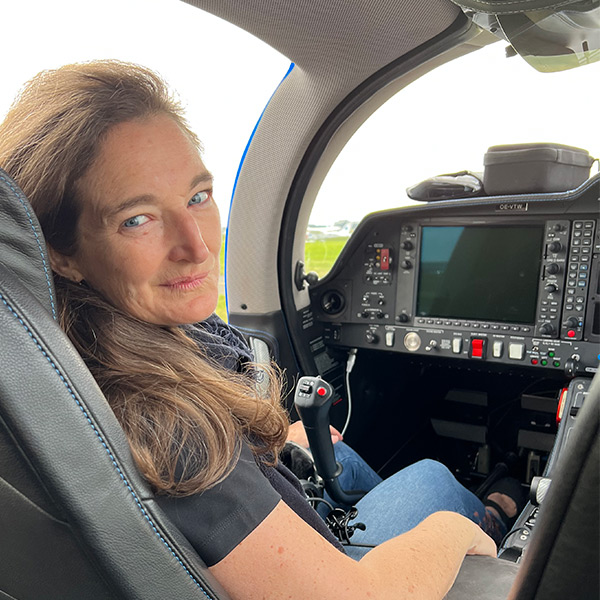Telex claims that the Stratus gives you 50 dB or more of active and passive noise reduction - taking away the higher-pitched vibrations emanating from in front of the firewall - for a total package that compares favorably in cockpit use to the arguably top-of-the-line Bose Aviation Headset X models.
The Stratus 50-D lists for $875, with average retail prices just under $800. Telex offers a rebate program for active flight instructors, taking $15 to $125 off prices on its headsets, depending on the model. The headset is robust; the model we tested weighed 23.2 ounces without the battery box. A cord to power the headset off of the airplane's electrical system is also included; the headset retains its passive features - and still operates - if power is lost. For more information, contact Telex, 12000 Portland Avenue South, Burnsville, Minnesota 55337; telephone 952/887-5586; fax 952/887-5595; or visit the Web site ( www.telex.com ).
Julie K. Boatman
Cockpit Automation For General Aviators And Future Airline Pilots
"The biggest remaining difference between the automated cockpits of a new Cessna 172 and a Boeing is the autothrottles," according to Steve Casner, author of the new book Cockpit Automation for General Aviators and Future Airline Pilots.
While the bold statement seems striking at first, a new Cessna does have much in common with its magic-jet brethren. Look inside any airplane-if you see an autopilot, moving-map global positioning system (GPS) unit, lightning detection system, and fuel computer, you'll realize that this sophisticated cockpit demands understanding and system management skills from its pilots.
Casner designed Cockpit Automation for General Aviators and Future Airline Pilots to address the need for these skills among general aviation pilots. By taking you step-by-step through the delights of two common GPS units, the Garmin GNS 430 and the Bendix/King KLN 94; autopilots (S-Tec makes the example used); and weather radar, traffic, and terrain displays, Cockpit Automation for General Aviators and Future Airline Pilots teaches you how to integrate the systems to your advantage. This book is about the big picture, one that may escape you when trying to learn each cockpit box in isolation from its peers on the panel.
Cockpit Automation for General Aviators and Future Airline Pilots retails for $26.39 and includes a DVD with video presentations of each task for which there is a detailed explanation in the book. The 178-page book features clear illustrations by Douglas A. Dupuie.
For more information, contact Iowa State Press, 2121 State Avenue, Ames, Iowa 50014; telephone 800/862-6657 or 515/292-0140; fax 515/292-3348; or order online through the Web site ( www.isupress.com ).
Rod Machado's Private Pilot Workbook
There are many paths to learning, which explains why one student thrives with a given instructor while another would swear that the same CFI didn't speak English. If you learn best when engaged with humor, you might give Rod Machado's private pilot training system a try.
Regardless of who speaks the aviation tongue best to you, you need a little interaction before the knowledge sets in its teeth. Machado's recently released Private Pilot Workbook addresses this need when used in conjunction with his Private Pilot Handbook. Each chapter provides questions that correspond to the same chapters in the handbook, with reference page numbers so that you can easily look up the explanation behind every one. Some graphics are in color; all of the figures are clear and well-produced. The workbook also includes a Part 141 training syllabus - which can be adapted to Part 61 courses - and stage exams.
The questions are thoughtful and not simply regurgitations of the material - or those questions found on the FAA exams. The workbook retails for $24.95. Additional resources are available on Machado's Web site, including favorite clips from his popular presentations, just for fun. But with Machado, learning to fly is all about having fun while you're doing it. For more information, contact The Aviation Speakers Bureau, Post Office Box 6030, San Clemente, California 92674-6030; telephone 800/437-7080; or visit the Web site ( www.rodmachado.com ).
Briefly Noted
Wondering how you'll get up to speed on the latest panel magic? ElectronicFlight Solutions, Inc., in partnership with the Aircraft Electronics Association, is building a network of qualified flight instructors to fill this need. The company has developed an innovative series of self-paced, multimedia avionics training programs designed for flight instructors to incorporate into their student syllabi. The package includes a five-volume CompleteLearning Avionics Library (covering weather, terrain, autopilot, traffic, and GPS topics), a software license for the CFI's training, one student module for the instructor to sell ($295 suggested retail), and access to the ContinuousLearning Web site including updates for a year. The package cost is $395. For more information, visit the Web site ( www.electronicflight.com ).
Aviation Supplies and Academics (ASA) has updated its powerful GPS Trainer software to include three new GPS unit tutorials. The program now allows users to select from the Garmin GNS 530, GNS 430, or GPSMap 295; the Bendix/King KLN 94 or 89B; or the Apollo GX50/60. Manufacturers' operating manuals and simulators are loaded on the CD-ROM, along with FAA documents that cover GPS function and use. Tutorials are organized into five sections: theory, preflight, en route, terminal, and approach. GPS Trainer retails for $99.95. For more information or to order, contact Aviation Supplies and Academics, 7005 132nd Place Southeast, Newcastle, Washington 98059-3153; telephone 800/426-8338 or 425/235-1500; fax 425/235-0128; or visit the Web site ( www.asa2fly.com ).



